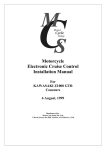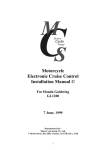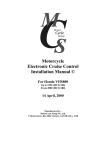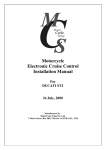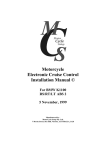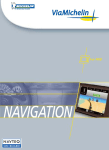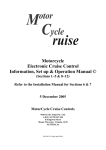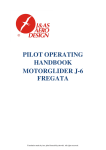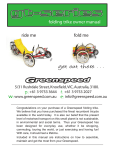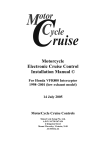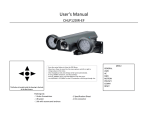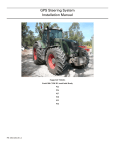Download Motorcycle Electronic Cruise Control Installation Manual ©
Transcript
Motorcycle Electronic Cruise Control Installation Manual © For Honda PC800 Pacific Coast 20 October, 1999 Manufactured by MotorCycle Setup Pty. Ltd. 7 Moritz Street, Box Hill, Victoria, AUSTRALIA, 3128 Honda PC800 Pacific Coast © MotorCycle Setup Pty. Ltd. Electronic Cruise Control Installation Manual © To suit Honda PC800 Pacific Coast Your electronic cruise control has been adapted from an Australian designed, automotive cruise control specifically to suit your motorcycle. Months of testing have resulted in changes to the electronic circuitry to deliver safe, reliable operation on the motorcycle models listed above. It is essential that you install the correct kit to your motorcycle and follow the installation instructions precisely so that electrical interference does not cause the unit to behave erratically or be rendered inoperative. WE STRONGLY RECOMMEND AGAINST FITTING OFF-THE-SHELF MOTOR CAR CRUISE CONTROLS TO ANY MOTORCYCLE! If, after reading these instructions, you feel you are not competent to install this kit, we strongly urge you to seek the assistance of one of our authorised dealers and installers. Please phone or email us to obtain the name of your nearest outlet. CONTENTS 1. INTRODUCTION 2. WARNINGS, CAUTIONS AND NOTES 3. TOOLS REQUIRED 4. PARTS LIST 5. OVERVIEW OF CRUISE CONTROL OPERATION 6. PREPARING THE BIKE FOR CRUISE CONTROL INSTALLATION 7. INSTALLATION 8. DIAGNOSTIC MODE OPERATION 9. MANUAL ADJUSTMENTS TO THE BRAKE PEDAL AND FRONT BRAKE LEVER 10.OPERATING INSTRUCTIONS 11.SAFETY FEATURES 12. ROAD TEST AND ADJUSTMENTS 13. TROUBLE SHOOTING, TESTING & SELF DIAGNOSTICS 14.RIDING TIPS 2 Honda PC800 Pacific Coast © 1. INTRODUCTION Congratulations, you have purchased one of the most advanced cruise control systems in the world - and the first model specific after-market electronic cruise control kit adapted to motorcycles. Your new cruise control has more operating features than many units costing much more. All functions are microprocessor controlled, which reduces the complexity of installation. Before installing your cruise control, take the time to read and understand each installation step in this manual. Several steps are dependent on others, so it is important know where and how each component is to be mounted before installation commences. Your kit has been designed for a specific motorcycle. Even if you have installed kits before, take note of where and how components should be installed - particularly the wiring harness layout and connections. 2. WARNINGS, CAUTIONS and NOTES This manual contains several cautions, warnings and notes, which are prominently displayed. The convention used is: A warning applies whenever injury could result from ignoring the warning; A caution applies whenever damage to the bike or cruise control could result from ignoring the caution; and A note applies where other aspects should be considered before any action to do with installation is undertaken. EXAMPLES: WARNING: Always ensure the bike is properly supported on the side or centre stand and cannot accidentally fall off either stand. CAUTION: Before drilling any holes, make sure there are no components that may be damaged on the other side of the surface being drilled. Double check for any wiring harness which might be easily damaged by a drill bit. NOTE: Lay the wiring harness in place and connect the components before cable tying the harness in place. 3. TOOLS REQUIRED A comprehensive set of tools. The list below includes many of the items required, but does not necessarily include all items for all kits/models. It is provided for guidance only in determining whether you might be able to fit the unit yourself. • • • • • • • • 8mm, 10mm & 12mm sockets and spanners; Phillips head screwdriver; Flat blade screwdriver; Long nose pliers; Set of metric allen (hex) keys; 3 A roll of black insulation tape; Loctite 243 or 222; Electric or hand drill with a 4.5mm drill bit; Honda PC800 Pacific Coast © 4. PARTS LIST Check that all components depicted in the parts list at the rear of this manual are included in the cruise control kit. Please phone (03) 9808 2804 within Australia, international (61 3) 9808 2804 or fax (61 3) 9808 2445 for advice, if any parts are missing; 5. OVERVIEW OF CRUISE CONTROL OPERATION The principles behind your cruise control's operation are very simple: • The computer continuously monitors the frequency of electrical pulses generated by magnets passing the sensor; • When the SET key on the switch is pressed the computer stores the pulse frequency at the time in memory and then continuously adjusts the vacuum actuator, which controls the carburettors to maintain the pulse frequency at the same figure to which it was set. If the frequency drops below the set frequency, the computer applies more throttle. If the frequency is above the set frequency, the computer turns the throttle off. The key is that the computer monitors and reacts to changes very quickly and smoothly so that the speed effectively remains nearly constant. There are six major components in your kit: the computer, the vacuum actuator, the speed sensor, the switch, the Electronic Clutch Switch (ECS) and the loom. The functions of each are described below: • • • • • • the computer - monitors road speed, adjusts the throttle by controlling the vacuum actuator, monitors the switch and brake system for instructions from these components; the vacuum actuator - controls the carburettors by pulling or releasing a cable which attaches to the carburettors; the speed sensor - generates electrical pulses when the bike is in motion; the switch - sends instructions from the rider to the computer; The ECS - monitors engine speed through the ignition system and disengages the cruise control if a rapid increase in engine revs occurs - for example, if the clutch is operated accidentally while the cruise control is engaged. the electrical loom - which connects the switch, the computer, the ECS, the vacuum actuator, the sensor and the brake system. When the cruise control is operating, it is possible to roll the throttle off by hand, thus opposing the cruise control actuator. As this will result in a loss of speed the cruise control computer will ‘read’ this as the bike going up an incline, and attempt to apply more throttle. If the twist grip is released again, it is possible for the throttle to go immediately to full throttle. While the throttle will back off again as soon as the set speed is reached or if the rate of acceleration exceeds the cruise controls preset rate (1 ~ 2 km/h gain in speed per second), the initial acceleration could be quite violent. As a result, we do not recommend manually forcing the throttle off while the cruise control is engaged. If the throttle grip is twisted open while the cruise control is engaged the cruise control is over ridden by the rider. When the throttle is released, the cruise control will resume control, unless it has been disengaged by brake operation or if the motor cycle exceeds the current set speed by 150% such as during an overtaking manoeuvre. The cruise will also disengage if the speed drops to 75% of set speed such as when riding up hill. This is unlikely to occur on large capacity motorcycles. 4 Honda PC800 Pacific Coast © 6. PREPARING THE BIKE FOR CRUISE CONTROL INSTALLATION Remove the seat, top shelter and both side covers etc. using the following procedure. Remove the seat by undoing the two mounting bolts at the back from inside the luggage compartment. It may be necessary to undo one end of the luggage compartment lid support strut in order to pull the seat out backwards through the luggage compartment. The Honda workshop manual says that the seat may be removed with the compartment lid closed half way, then draw the seat back to disengage the front mounting tab. The seat may then be removed from the bike. Remove the two centre covers that surround the head stem area, in front of the top shelter. Remove the air ducts in the sides of the fairing by pulling the rear edge away from the body, then slide the duct backwards. Remove the side covers by removing the attaching screw (at the rear of the air duct hole), slide the cover backwards slightly and pull it free of its attaching grommets. Remove the top shelter (dummy fuel tank) by removing the two flange nuts at the front and two flange bolts at the lower rear. Remove the right hand crash bar cover. Remove the right hand brake calliper/disc cover (front disc brake cover) if fitted (earlier models only). There are two socket head screws holding this on, one in the front vent, one in the rear vent. Be careful not to break any of the mounting tabs while removing the cover. THE FOLLOWING IS ESSENTIAL TO SAFE AND SMOOTH OPERATION OF THE CRUISE CONTROL. We have experienced a new bike that had been in storage, and the throttle cables had corroded slightly. This increased friction to the point that the throttle would not return by itself. The following measures will ensure that the cables will operate with minimum friction and will not corrode. Disassemble the right hand switch block and run 6 drops of VERY light oil (sewing machine oil or similar) down each throttle cable. DO NOT USE MOTOR OIL ON THE THROTTLE CABLES. Clean the handlebar under the throttle grip and the bore of the throttle grip and then apply a few drops of motor oil or apply a VERY THIN SMEAR of grease and then a few drops of motor oil to the handlebar where the throttle grip turns on the handlebar. Reassemble the right hand switch block and adjust the throttle cables so that there is 1~3mm (1/16”~1/8”) free movement of the throttle grip at the rubber flange next to the switch block. 5 Honda PC800 Pacific Coast © 7.0 INSTALLATION 7.1 Installing the control switch Position the cruise control switch under the cover as shown in the photos and mark the position of the mounting holes. Disassemble the handlebar cover as follows. Remove the plastic cover surround on the ignition switch by pulling up at the front edge. This will reveal three screws. Remove these three Philip’s head screws, one behind the ignition switch and one either side of the choke knob. Remove three screws from each side of the cover. They are on the underside of the handlebar switch assemblies. Two are hidden inside recesses; the third is clearly visible. Remove the top half of the cover, the headlight and engine kill switches are part of the cover and will come with it. Remove the bottom half. Pull the left side out enough to remove the three screws that mount the horn and indicator switch in the cover. Drill two 4.0~4.5mm diameter holes through the cover. Mount the switch to the cover using the two M4 X 6 pan head screws supplied after applying a suitable thread locker such as Loctite 222, 242 or 243 to the screw thread, place the flat washers under the heads of the screws. Use the switch bracket backing plate on the inside of the handlebar cover and attach the switch to the bottom handlebar cover. Route the switch wire through the hole near the clutch lever, or if desired, file a suitable hole in the cover at the join for the wire. Run the wire down the cover, and out on the left side of the steering stem, then down the top frame spar on the left side of the motor. Reassemble the handlebar cover. 6 Honda PC800 Pacific Coast © 7.2 Installing the actuator and carburettor linkage. Undo the two screws (upper and lower) that hold the right hand fairing panel at the rear edge. Gently pull the panel out enough to insert the vacuum actuator so that it nestles inside the right hand crash bar. Route the actuator cable to the rear, just inside the lower side panel, then up, outside the frame main spar, inside the top rail of the frame near the front of the fuel tank. Route the actuator cable over the bolted on cross brace that is above the front of the fuel tank. Cable tie LOOSELY in position as shown. Route the cable around the back of the fuel filler. It should terminate at the carburettors on the left side. Attach the vacuum actuator to the right hand frame rail using the hose clamps supplied as shown in the photographs. Use electrical tape, duct tape or similar on the frame rail to prevent scratching the paint. The photo shows the actuator looking down into the cavity below the fairing air vent. The photo at left shows the actuator located inboard of the crash bar. Reinstall the two screws holding the right hand fairing panel rear edge. 7 Honda PC800 Pacific Coast © Undo the two bolts that attach the rear luggage compartment release lever to the frame. They are located under the fuel filler on the left side. Locate the flexible cable bracket as shown in the photo and replace the bolts after applying a suitable medium strength thread locker. The throttle cables attach to the carburettors on the left hand side of the bike. Undo the nut that attaches the throttle cable spool to the carburettors, remove the lock washer and store it as it will not be re-used. Position the carburettor arm on the carburettor spindle as shown in the photo. Apply a suitable medium strength thread locking compound to the threads (Loctite Blue 242 or 243) and reinstall the nut WITHOUT the washer and tighten gently. Be careful not to strip these threads as replacement of the carburettor spindle will be VERY expensive. Pull the actuator cable outer backwards until all the slack in the cable is taken up. Hold the actuator cable outer next to the flexible cable bracket just above the slotted hole and mark the cable at the mid point of the slotted hole. Attach the flexible cable clamp to the actuator cable at this point. Assemble the flexible cable clamp to the flexible cable bracket using the M6 X 16 bolt and a flat washer from behind the bracket, then a flat washer, the flexible cable clamp, another flat washer then the M6 Nyloc nut on the outside. Position the cable in the slotted hole to give 1~3mm (1/16”~1/8”) of free play in the actuator cable. Tighten the nut and ensure that the actuator cable has a straight run to the carburettor arm. Re-check the free play in the cable is 1~3mm. Too much free play will compromise the performance of the cruise control. Too little will prevent the carburettors returning to idle. Check that the throttle operates without restriction, that it snaps shut when released and that there is NO possibility of any hoses or other motorcycle parts getting tangled in the actuator cable or carburettor arm. If there are any other parts interfering with the throttle parts MOVE THEM and secure them out of the way. WARNING Your cruise control is designed with numerous safety features, but none of these can prevent a runaway condition caused by a tangled or jammed throttle linkage. DOUBLE CHECK IT. 8 Honda PC800 Pacific Coast © There is a hose with a terminating cap on it for checking the carburettor balance. This is located on the right side of the carburettors just under the air cleaner housing. Remove the cap and store it as it will not be re-used. Attach the short end of the vacuum hose to the end of the balance port hose. Route the hose to the actuator carefully to avoid the hose being pinched, kinked or damaged. Attach the other end of the hose to the actuator hose barb. The black end or the vacuum stop valve should be on the carburettor side, the white end on the actuator side. 7.3 Installing the speed sensor. Undo the lower of the two calliper mounting bolts on the right hand front brake calliper. Locate the speed sensor bracket as shown and install the bolt with medium strength thread locker on the threads. Position the sensor bracket so the front edge of the bracket follows the line of the front forks. The sensor should be over the pitch circle of the front disc mounting bolts. Place one of the magnets in the head of a disk mounting Allen screw on the front right brake disc. Attach the other magnet to the first to check the polarity of the magnet then slide the magnet off and insert it into the bolt that is diametrically opposite the first bolt WITHOUT TURNING THE MAGNET AROUND. The magnets must be spaced evenly (180° apart) and have the same face outwards, otherwise the cruise will not work. Rotate the front wheel so that a magnet is under the speed sensor. The gap should be 6 ~ 10mm (1/4” ~ 3/8”). Correct the gap if required by adding or removing flat washers to the sensor mounting stud or by bending the sensor bracket. DO NOT ADD WASHERS TO THE BRAKE CALIPER MOUNTING BOLT. 9 Honda PC800 Pacific Coast © 7.4 Installing the wiring loom and computer. Plug the 12 pin computer plug into the computer and place the computer on the front of the front wall of the luggage compartment on the left side of the bike. Ensure the loom will wrap around under the computer without the luggage compartment cover fouling the loom when the cover is closed. Clean the back of the computer and the luggage compartment wall with methylated spirits (wood alcohol or white spirits). Apply the double-sided tape to the computer and mount the computer to the luggage compartment wall. Alternatively, the computer may be screwed to the wall if desired (the screws are NOT supplied in the kit). Run the loom down under the computer. Locate the fuel pump, which is on the left side of the bike beside the fuel tank and towards the rear. Disconnect the two pin electrical connector that provides power to the fuel pump. This is usually the inside most connector of the three on the front of the luggage compartment wall. Plug the matching ends of the cruise control loom plugs into the two free ends of the disconnected fuel pump wire so the original fuel pump plugs are bridged. You can put one of the plugs back into the mounting bracket if you wish, but this is extremely difficult without removing the luggage compartment lid. Run the leg of the loom with the brake sensor plugs and the actuator plugs inside the frame behind the fuel tank and up to where the rear brake light switch is plugged into the bike's loom. This can be found by tracing the wire back from the rear brake light switch. Disconnect the brake light switch connector and plug in the matching plugs on the cruise loom so that the brake switch connectors are bridged. Continue running the actuator connectors to the right side of the bike and forward to the area behind the right hand crash bar and connect the three connectors to the actuator connectors. Make sure the colour codes of the wires match. 10 Honda PC800 Pacific Coast © Run the other leg of the loom with the switch connector and the speed sensor connectors on it forward up the left side of the bike past the fuel tank and the engine following the frame spar. The switch plug should be on top of the frame spar, just forward of the rear cylinder head. Connect the switch wire to the cruise loom. Run the speed sensor wire around the steering head and down the hydraulic line to the right hand brake calliper and connect the wires to the speed sensor. It may be easier to remove the sensor bracket to connect the wires as shown in the photo. The polarity of these wires does not matter. Cable tie the sensor wire to the sensor bracket on the tab provided. Ensure that the sensor wire and switch wire are not stretched or crushed when the handlebars are turned. Cable tie the sensor wire to the brake fluid line in a few places using the small cable ties supplied. Cable tie the switch wire at appropriate intervals. Cable tie the loom to the frame at several suitable points using the cable ties provided. 7.5 Installing the Electronic Clutch Switch (ECS). Mount the ECS to the back of the fuel tank on the left side using the two self adhesive pads provided. The photo is taken looking down at the fuel tank showing the left rear corner of the tank. 11 Honda PC800 Pacific Coast © Route the two pin plug with the orange and purple wires to the matching plug on the cruise control loom (near the 12 pin computer plug. Route the green earth (ground) wire to the bolt on the frame. Route the yellow ignition wire forward with the main cruise control loom to the ignition coil. The coil is visible through the access hole in the left side of the fairing. Disconnect the yellow/blue wire on the coil. This wire should be on the bottom terminal on the ignition coil. Connect the yellow/blue wire to the piggy back terminal on the yellow ECS wire, then push the terminal on to the ignition coil terminal. Cable tie the wires where necessary. Your cruise control is now ready for testing! 8. DIAGNOSTIC MODE OPERATION Your cruise control comes with a means of making it operate the throttle without the speed sensor detecting movement. This is the best way to check that the electrical and mechanical operation of the cruise control is working properly - excluding speed control circuits. Note:- During the diagnostic checks many of the features of the cruise control are confirmed by the LED (light) on the computer operating. For example, brake switch operation is confirmed by the LED. The LED only stays on for a few seconds with most operations. If the brake pedal is pushed, the LED will come on. If the pedal is held after a few seconds the LED will go out. If the pedal is released and re-applied, the LED will come back on, and then turn off after a few seconds. THIS IS NORMAL AND DOES NOT INDICATE A FAULT IN THE CRUISE CONTROL. This applies to most operations performed in diagnostic mode. 12 Honda PC800 Pacific Coast © • • • • • • • • • • • • Turn the cruise control ON/OFF switch to OFF; Turn the ignition switch ON but DO NOT start the engine. Check that the kill switch is also ON. Depress and hold the SET key while turning the cruise control ON; Take your finger off the SET key; Pull the front brake lever and depress the rear brake pedal a few times. The LED on the computer should illuminate when EITHER lever is used. This indicates that the cruise control will cancel when the brakes are applied. If the LED does not come on, the most likely cause is incorrect adjustment of the brake switches. If either of the switches is adjusted so that it does not turn OFF at all, the light WILL NOT COME ON AT ALL. It is then necessary to adjust the switch so that it turns OFF when the brake is released. IF THE BRAKE SWITCH OPERATION IS NOT CONFIRMED BY THE LED OPERATING ON THE COMPUTER NOTHING ELSE WILL WORK ON THE CRUISE CONTROL. See the next section. Now tap the SET key once while listening for a click from the vacuum actuator and watching the red LED on the front of the computer. You should hear the click and see the LED flash. Depress and hold the SET key. The LED should come on a stay on while the SET key is depressed and regular clicks should be heard from the actuator. Now tap the RES key once while listening for a click from the vacuum actuator and watching the red LED on the front of the computer. You should hear a slightly different sounding click and see the LED flash. Depress and hold the RES key. The LED should come on a stay on while the RES key is depressed and regular clicks should be heard from the actuator. Turn the cruise control power switch OFF; Start the bike in neutral; Depress and hold the SET key while turning the cruise control ON; Take your finger off the SET key; Now tap the set key once while listening for a click from the vacuum actuator and watching the red LED on the front of the computer. If you hear the click and see the LED flash, tap the SET key a few more times until the revs start to rise. Depress the RES key and the revs will drop. Some delay occurs with these operations. CAUTION: You need to be careful not to tap the SET key too many times as it is easy to over-rev the engine if you tap it too often. If the engine revs too fast quickly turn off the cruise control switch OR the bike’s KILL switch. If the ECS (electronic clutch switch) is working correctly it should protect the engine by shutting off the cruise control before such high revolutions are reached; CAUTION: IT IS VERY EASY TO OVER-REV THE BIKE IN THE NEXT STEP - SO BE CAREFUL! • When you are sure single taps work, depress and hold the SET key for a couple of seconds and see if multiple pulses are sent to the actuator. Listen for clicks and look at the LED. Checking the ECS: With the cruise in diagnostic mode with the engine running, observe the red LED indicator on the clutch switch and the LED on the computer. Quickly rev the engine by ‘blipping’ the throttle. The LED’s should illuminate briefly as the engine reaches 2,000~3,000 RPM if the engine starts from idle. The slower the rate of increase of revs, the higher the revs required to make the LED light. A quick blip should resulting in the LED coming on at about 2,000~2,500 RPM. A slow increase in revs may not see the LED coming on until 4,000 RPM or more. When the LED’s come on it indicates that the cruise control will be cancelled. Using the bikes throttle raise the engine speed to the same revs that would be used at typical ‘cruising speed’ ie about 100kph (60mph), typically 3500~4000 RPM. The LED on the ECS should come on. Hold the engine speed constant. The LED should turn off after 5~20 seconds. 13 Honda PC800 Pacific Coast © If the LED does not turn off after 30 seconds, the cruise control may not work and the sensitivity of the switch may need to be adjusted. The adjustment procedure is described in Section 12, Road Test and Adjustments. NOTE: 9. Remember to wait at least 5 seconds after turning the cruise control off when in diagnostic mode to then use it in cruise control mode – otherwise it stays in diagnostic mode. It takes time for the capacitor which protects the computer from surges in the power supply to discharge fully. MANUAL ADJUSTMENTS TO THE BRAKE PEDAL AND FRONT BRAKE LEVER Since the brakes are the fastest way to turn the cruise control off, it is ESSENTIAL that they be adjusted optimally to suit the rider AND that they activate the rear brake lamp as quickly as possible. It is recommended that both front and rear brakes be set up so that the brake lamp turns on as early as possible when either brake is applied. Naturally you have to ensure that the brake lamp does turn off - otherwise the cruise control will not work at all. Careful adjustment of the foot brake lever so that the rider's foot does not have to lift up to reach it is recommended. Next, adjust the brake switch so that it turns on with very little movement of the brake pedal. Repeat this process with the front brake lever. It is recommended you adjust the rest position of the gear lever to the foot brake lever for optimum rider comfort. NOTE: 10. IF THE REAR BRAKE LIGHT FILAMENT OR FUSE BREAKS, OR THE BRAKE LIGHT IS ON, THE CRUISE CONTROL WILL NOT WORK AT ALL. IF YOUR CRUISE CONTROL APPEARS NOT TO BE WORKING, THESE ARE THE FIRST THINGS TO CHECK. OPERATING INSTRUCTIONS Although your cruise control has many operating features, it has been designed to be very easy to operate. Its operating range is from about 40kph (25mph) (not recommended) to approximately 180kph (115mph) (also NOT recommended). The cruise control operates by monitoring the road speed of the bike and uses a computer to maintain any ‘set’ speed within its operating range. The computer is instantly de-activated by either front or rear brake lever pressure sufficient to turn on the brake lights. All commands are input using the three switches on the switch block. The functions performed by each key are as follows: ON/OFF Switch The OFF-ON switch is a slide switch and ‘enables’ the SET/ACC (Set/Accelerate) and RES/DEC (Resume/Decelerate) keys when turned ON. The SET/ACC and RES/ACC switches are activated by depressing them. Turning the OFF-ON switch OFF disables the cruise control. SET key - maintains bike speed or produces acceleration 14 Honda PC800 Pacific Coast © The SET key has four functions: 1. When the bike is in motion within the cruise control’s operating range, depressing and releasing the SET key sets the computer to maintain the speed at the time the SET key was depressed; 2. While the cruise control is controlling the bike’s speed, firmly but quickly tapping the SET key increases the set speed by about 1.5kph (1mph) for each tap. Six (6) taps in rapid succession increases the set speed by approximately 10kph (6mph). Different bikes respond slightly differently. Experiment until you find out precisely how your bike responds; 3. While the cruise control is controlling the bike’s speed, depressing and holding the SET key results in the bike smoothly accelerating until the SET key is released (or until the bike achieves the cruise control’s maximum operating speed - this is not recommended). The rate at which acceleration takes place is a function of the power of the bike and the position of the sensitivity switch [Refer to section 10] on the cruise computer; 4. Used in conjunction with the ON/OFF switch, it puts the cruise control in ‘diagnostic mode’. While riding the bike, the cruise control can be set to a higher speed by: a. Opening the throttle and pressing the ‘SET’ key after the required speed is reached; b. Tapping the ‘SET’ key to progressively accelerate the bike; c. Depressing and holding the ‘SET’ key until the required speed is reached. RES key - resumes the bikes previously set speed or decelerates the bike. 1. If the cruise control has been controlling the bike’s speed and has been deactivated using the brakes AND the cruise control or engine have not been turned off, depressing and releasing the RES key causes the cruise control to return to its previously set speed; 2. If the cruise control is controlling the bike’s speed, tapping the RES key decelerates the bike by approximately 1.5kph per tap; 3. If the cruise control is controlling the bike’s speed, depressing and holding the RES key down, decelerates the bike until it is released or the bike slows beyond the cruise control’s operating range. Releasing the key sets the computer to the current speed. NOTE: 1. If the bike’s speed drops below 75% of the SET speed, the cruise control deactivates by itself. This could happen on a very steep incline, but is very uncommon on large capacity bikes. If it does, simply accelerate using the throttle and SET the cruise control again. 2. If the bike’s speed increases to 150% of the SET speed, the cruise control deactivates by itself. This can happen when accelerating to pass a car. If it does, simply decelerate using the throttle and SET the cruise control again. 15 Honda PC800 Pacific Coast © 11. SAFETY FEATURES The cruise control can be shut off by any of the following methods: a. b. c. d. e. f. g. Depressing either brake pedal/lever; Sliding the ON/OF switch to the OFF position; Decelerating to 75% of the set speed; Accelerating to 150% of the SET speed; Pulling in the clutch lever to trigger the ECS; Pressing the kill switch on the engine; Turning off the ignition key. The cruise control will disengage if any of the connectors become separated, if the brake light filament breaks or the brake lights lose power - for example if a fuse blows. There are numerous safety features designed into the computer and throttle actuator to ensure that should one or more components fail there is still a way to turn off your cruise control. For safe and economical motoring NEVER operate this or any cruise control in: • congested or heavy traffic; • on wet or slippery roads. WARNING: Your cruise control is designed with numerous safety features, but only the motorcycle KILL SWITCH or the IGNITION KEY can overcome a runaway condition caused by a tangled or jammed carburettor linkage. Regular inspection of control cables is recommended to prevent jamming of the throttle, which could occur if cables were frayed or damaged. 12. ROAD TEST AND ADJUSTMENTS Your cruise control comes pre-adjusted from the factory and if installed properly should provide satisfactory performance on most bikes. To determine whether adjustment is necessary, perform the following road test: 1. Slide the ON/OFF switch to the on position; 2. Hold the SET key down and slowly accelerate the bike from 30kph to 50kph (20mph to30mph) using the throttle. The cruise control should take over at about 40kph (25mph); 3. Depress one of the brake levers to turn the cruise control off; 4. Use the throttle to accelerate the bike up to 80kph (50mph) and press the SET key. The cruise control should engage and smoothly maintain speed within 2kph (1.5mph); 16 Honda PC800 Pacific Coast © • If the cruise control loses speed when engaged or is sluggish, increase the sensitivity adjustment by setting the sensitivity switch on the computer to the ‘H’ (High) position; • If the cruise control gains speed when engaged or is erratic, decrease the sensitivity adjustment by setting the sensitivity switch on the computer to the ‘L’ (Low) position. • MotorCycle Setup recommends you use the MEDIUM sensitivity switch position. Motor cycle engines can produce rapid, unexpected and uncomfortable acceleration when controlled by the cruise control computer in high sensitivity mode. Testing the electronic clutch switch. The ECS switch may be road tested by setting the cruise on a suitable speed (ie. 60kph or 35 mph) while on a level road or slight uphill, and pulling in the clutch. The engine will rev higher initially but should drop quickly (within 1/2 second) back to idle. If this takes longer than this, check that there is no excess friction in the throttle mechanism that is slowing down the throttle and not allowing it to ‘snap’ shut. The sensitivity of the switch is adjustable. The bottom of the box may be opened by releasing the two catches next to the wire entry hole. Beside the wire connection plug on the circuit board there is a black plastic ‘jumper’ block. This is a bridging connector to allow the two pins to be connected. This may be connected or disconnected from its pins to tailor the way the switch responds. Bridging the pins decreases the switches sensitivity. This may be appropriate on fast revving sports engines. Disconnecting the pins increases the sensitivity. This is appropriate on slower revving touring engines. Try both settings to see what is suitable for your engine. • The switch is supplied on the most sensitive setting with the jumper disconnected. The jumper is installed on one pin. The jumper may be removed, using a pair of long nose pliers, and then re-installed on both pins to decrease the sensitivity of the switch. • If you cannot get the cruise to work at higher speeds jumper the pins to decrease sensitivity. If the switch takes too long to work, disconnect the pins to increase sensitivity. • This completes the adjustment procedure. 13. TROUBLE SHOOTING, TESTING AND SELF-DIAGNOSTICS See the attachment for detailed instructions. WARNING: The computer, switch block and other components are water resistant - NOT WATERPROOF. When washing the bike avoid spraying or pouring water directly onto any component. It is recommended the switch be covered during washing. 17 Honda PC800 Pacific Coast © The staff at MotorCycle Setup hope you enjoy using your new cruise control and use it wisely and safely. Remember that cruise controls are not a licence to concentrate less while riding. We recommend you approach all other road users with greater care when using the cruise control and use substantially larger safety margins when riding in traffic. Its use in built-up areas is not recommended. You will probably find using the cruise control a bit disconcerting at first until you get used to the throttle moving under your hand and the slight ‘hunting’ (acceleration and deceleration) of the bike downhill. It is not possible to eliminate the latter effect as the computer continuously attempts to balance its set speed with the road speed. NOTE: Practice turning the cruise control off quickly so that you will be ready for any emergency. Experience suggests touching the footbrake is the best and quickest way to turn the cruise control off. If by chance you are not holding the right handlebar when you need to make an emergency stop, the first reaction is to grab the front brake and clutch. In doing so, you may inadvertently hold the throttle open depending on how much throttle the cruise control had applied at the time. If this happened the engine revs would rapidly rise because the clutch was disengaged. You may think the cruise control is malfunctioning. Release your grip on the throttle and the bike should return to idle. The best way to avoid this occurrence is to practice rolling the throttle off whenever you use the front brake. 14. RIDING TIPS The cruise control engages most smoothly when the engine is under load. We recommend SETTING or RESUMING cruise operation while holding a constant speed. Maintain speed using the throttle: a) for a couple of seconds after pressing the SET key to allow time for the cruise control to take up cable free play; and b) until you feel the cruise take over after pressing RESUME. 18 Honda PC800 Pacific Coast © Honda PC800 Pacific Coast Parts list for MCS 1150A kit Item 1 Qty 1 2 3 1 1 3 2 4 5 6 7 8 9 1 1 1 1 1 1 10 11 12 13 14 1 1 1 3 1 Description Computer MCS 1153 MCS 020 MCS1153A Vacuum actuator assembly Vacuum actuator actuator bracket 6 gauge x 3/8” pan head self tap screw Hose clamps Hose Clamp 24 MCS 1155 MCS 1155A MCS 025A MCS 025B MCS 025C Carburettor arm assembly Carburettor arm 4mm shouldered screw 5mm eye bead chain connector Bead chain and coupling 4mm flat washer M4 Nyloc nut MCS 1156 MCS 1156A MCS 024A Flexible cable bracket assembly Actuator flexible cable bracket Flexible cable clamp M6 x 16 plated bolt 6mm plated flat washer M6 Nyloc nut 1 MCS 1159 MCS 032 Vacuum hose assembly Vacuum stop valve 4mm Vacuum hose 1 MCS 1152 Wiring loom Computer plug (12 pin) Fuse holder (3 amp fuse) Switch plug (4 pin) Speed sensor connectors Actuator connectors Brake sensor connector (Black wires) Power and earth connector (black and green wires) ECS connection plug (2 pin) MCS 1154H MCS 019 MCS 1154HA MCS 1154A Control switch assembly Control Switch Switch bracket Switch bracket backing plate 4mm plated flat washer M4 x 6 pan head screw MCS 1151 MCS 1151A MCS 027 Speed sensor assembly Speed sensor bracket Speed sensor M6 Nyloc nut 6mm plated flat washer MCS 1150ECS MCS 028B Electronic Clutch Switch Self adhesive pads (to mount clutch switch) 15 16 Part Number MCS 02050H a b c d e f g h 17 18 19 20 21 1 1 1 2 2 22 23 24 25 1 1 1 3 26 1 2 19 Honda PC800 Pacific Coast © 2 10 4 2 MCS 039 magnet, 6mm dia x 6mm long MCS 030 100mm cable tie 200mm cable tie Self adhesive pad (to mount computer) Instructions Trouble shooting guide Warranty sheet M otor Cycle 4 C 5 ruise 3 68 15 9 7 1 2 14 11 a 16 b c d 12 h 13 13 g 10 f 24 19 22 17 18 SET / ACC RES / DEC 25 OFF ON 20 21 e 23 20 26 Honda PC800 Pacific Coast © MOTORCYCLE SETUP PTY. LTD. 12 MONTH CONSUMER SATISFACTION GUARANTEE Please return a copy of this part to MotorCycle Setup, 7 Moritz Street, Box Hill, Victoria 3128, or phone +61 3 9808 2804 when making a warranty claim. Name:_______________________________________________________________________________________________ Address:_____________________________________________________________________________________________ ___________________________________________________________________________________________ Telephone Number:____________________________________________________________________________________ Item Model Number:_MCS1150A________________ Date Purchased___________________________________________ Name of Retailer:______________________________________________________________________________________ Installed By:__________________________________________________________________________________________ Year, Make and Model of Motor ycle:______________________________________________________________________ I have read the warranty agreement below and accept its terms. Customer signature:____________________________________________________________________________________ Warranty service requires a copy of the sales receipt. 12 MONTH WARRANTY MotorCycle Setup Pty. Ltd., 7 Moritz Street, Box Hill, Victoria 3128, hereby warrant that it will repair or replace to the original purchaser products which prove to be defective under normal use and service in workmanship or material. MotorCycle Setup obligation under this warranty is limited to the repair or replacement of the product at its option without charge for parts and labour at its warehouse located at the above address at Box Hill, when the product is returned with postal charges prepaid and examination of the product shall disclose it not to have been defective in the respects aforesaid during the warranty period. The repairs or replacements will be made promptly and the repaired unit will be returned with all postal charges prepaid. Coverage under this warranty is limited to the original purchase of the product at retail. When requesting warranty service, copy of sales receipt or warranty registration number must be submitted. The warranty period for cruise controls is limited to a period of 12 months from the date of purchase. No warranty is implied for the installation and therefore MotorCycle Setup will not be responsible for installation of re-installation charges. This warranty does not apply to products or equipment or components used in conjunction with the cruise control. Warranty doe not cover unauthorised repairs, improper installation or application, damage or misuse or product which has not been maintained or used in accordance with the operating specifications as set forth in the written instructions. The warranty term shall not extend beyond its original term with respect to subsequent warranty replacement. Under no circumstances shall MotorCycle Setup be liable for consequential damages or breach of this warranty or for any implied warranty. MotorCycle Setup neither assumes nor authorises any person to assume for it or any obligation or liability other than herein expressly stated. MOTORCYCLE SETUP CUSTOMER SERVICE POLICY You will receive free consultation on any problem you might encounter in the assembly or use of MotorCycle Setup products. Just drop us a note, email us at [email protected] or give us a call on +61 3 9808 2804. You can obtain parts directly from MotorCycle Setup by writing to us. Use your packing list to describe your requirements. If you are not satisfied with our service or with our products, write direct to the Managing Director, MotorCycle Setup Pty. Ltd., 7 Moritz Street, Box Hill, Victoria, Australia, 3128. He will make certain your problem receives immediate personal attention. The benefits conferred by this guarantee are in addition to all other rights and remedies in respect of the product, which the consumer has under the Trade Practices Act, and other State and Territory Laws. 21 Honda PC800 Pacific Coast © This page intentionally blank 22






















